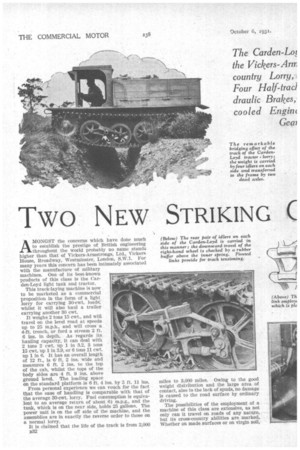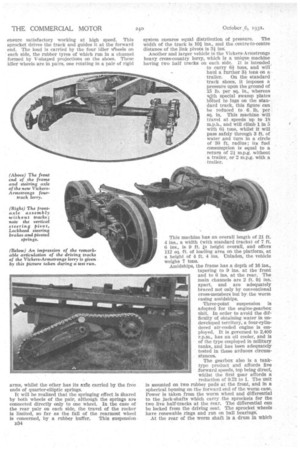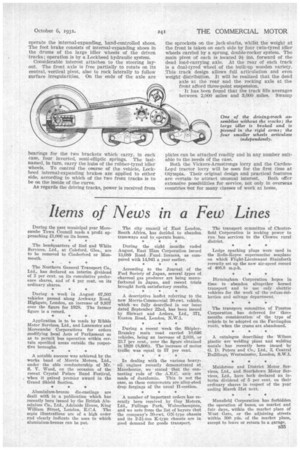Two NEW STRIKING C
Page 50

Page 51

Page 52

Page 53

If you've noticed an error in this article please click here to report it so we can fix it.
MSS-COUNTRY VEHICLES
The Carden-Loj the VickersArrr country Lorry, Four Half-traci draulic Brakes, cooled Engin(
• Tractor-lorry and 9ngs Heavy Cross
e Latter Having Steering by Hy )ur-cylindered Air znd Five speed Unit Gem
AMONGST the concerns which have done much to establish the prestige of British engineering
throughout the world probably no name standQ higher than that of Vickers-Armstrongs, Ltd., Vickers House, Broadway, Westminster, London, S.W.1. For many years this concern has been intimately associated with the manufacture of military machines. One of its best-known products of this class is the Carden-Loyd light tank and tractor.
This track-laying machine is now to be marketed as a commercial proposition in the form of a light lorry for carrying 30-ewt. loads', whilst it will also haul a trailer carrying another 30 cwt.
It weighs 2 tons 15 cwt., and will travel on the level road at speeds up to 25 m.p.h., and will cross a 4-ft. trench, or ford a stream 2 ft. 6 ins, in depth. As regards its hauling capacity, it can deal with 2 tons 2 cwt. up 1 in 3.2, 3 tons 15 cwt. up 1 in 3.9, or 6 tons 11 cwt. up 1 in 6. It has an overall length of 12 ft., is 6 ft. 2 ins, wide and measures 6 ft. 2 ins, to the top of the cab, whilst the tops of the body sides are 4 ft. 9 ins. above ground level. The loading space on the standard platform is 6 ft. 4 ins. by 5 ft. 11 ins. From personal experience we can vouch for the fact that the ease of handling is comparable with that of the average 30-cwt. lorry. Fuel consumption is equiva lent to an average return of about 43i m.p.g., and the tank, which is on the near side, holds 25 gallons. The power unit is on the off side of the machine, and the assemblies are in exactly the reverse order to those on a normal lorry.
It is claimed that the life of the track is from 2,000 3332 miles to 3,000 miles. Owing to the good weight distribution and the large area of contact, also to the lack of spuds, no damage is caused to the road surface by ordinary driving.
The possibilities of the employment of a machine of this class are extensive, as not only can it travel on roads of any nature, but its cross-country abilities are marked. Whether on made surfaces or on virgin soil,
the springing of the four idlerwheels on each side affords really satisfactory suspension. A. vital point to note is that the driving sprockets are isolated from contact with the ground, except when the machine goes forward into a deep ravine. This means that the driving axle has to withstand far fewer shocks than if the sprockets actually carried a proportion of the weight of the machine.
Turning now to the details of the Carden-Lloyd ; the frame consists of a steel punt through which pass two tubular axles that serve as pivots for the rockers, of the idler wheels. The Still-tubed radiator is at the back of the punt, and air is driven through it and out via spaces under the platform of the drop-sided body.
A 50 b.h.p., six-cylindered, o.h.v, engine is employed. This is of conventional design, but it has a specially large fan of the exhauster type, and the water pump is larger than usual, in order to ensure an adequate now, The radiator is replenished through a tank on the off side Of the vehicle, which also includes a steam-release valve to prevent an undue rise of pressure in the cooling system.
Power Passes from the engine through a clutch to the live-forward-speed gearbox and thence through a short propeller shaft to the live axle which embodies two imultiplo-plate clutches—one on each side of the bevels. These clutches are controlled by the two steering levers. The iirst portion of the downward motion of each lever releases its appropriate
clutch ; further motion applies' a brake on the same side. To make a wide turn, release of the clutch on the inner side of the curve is all that is necessary, further depression of the lever, which applies the brake, causes the turn to be much more rapid—in fact, the vehicle can be turned in its own length if so desired. Final drive is by spur reduction in the track sprockets. Turning now to the tracks. The teeth of each hardened sprocket ring register with Central spaces in each link ; the pitch has been kept small in order to B33 ensure satisfactory working at high speed. This sprocket drives the track and guides it at the forward end. The load is carried by the four idler Wheels on each side, the rubber tyres of which run in a channel formed by V-shaped projections on the shoes. These idler wheels are in pairs, one rotating in a pair of rigid arms, whilst the other has its axle carried by the free ends of quarter-elliptic springs.
It will be realized that the springing effect is'Shared by both wheels of the pair, although the springs are connected directly only to one wheel. In the case of the rear pair on each side, the travel of the rocker Is limited, so far as the fall of the rearmost wheel is concerned, by a rubber buffer. This suspension B34 system ensures equal distribution of pressure. The width of the track is 101 ins., and the •centre-to-centre distance of the link pivots is 3i ins: Another and larger vehicle is the Vickers-Armstrongs heavy cross-country lorry, which is a unique machine having two half tracks on each side. It is intended, to carry 61tons, and will haul a further 3/ tons on a trailer. On the standard track shoes, it imposes a pressure upon the ground of 15 lb. per sq. in., whereas with special swamp plates bSited to lugs on the standard track, this figure can be reduced to 6 lb. per sq. in. This machine will travel at speeds up to 18 m.p.h., and will climb 1 in 5 with 6/ tons, whilst it will pass safely through 3 ft. of water and turn in a circle of • 30 ft. radius ; its fuel consumption is equal to a return of 2i m.p.g. without a trailer, or 2 m.p.g. with a trailer.
This machine has an overall length of 21 ft. 4 ins., a width (with standard tracks) of 7 ft. 6 ins., is 9 ft. In height overall, and offers 112 sq. ft. of loading area on the platform, at a height of 4 ft. 4 ins. 17nladen, the vehicle weighs 7 tons.
Amidships, the frame has a depth of 16 ins., tapering to 9 ins, at the front and to 6 ins, at the rear. The main channels are 2 ft. 9/ ins. apart, and are adequately braced not only by conventional cross-members but by the worm casing amidships.
Three-point suspension is adopted for the engine-gearbox unit. In order to avoid the difficulty of obtaining water in undeveloped territory, a four-cylindered air-cooled engine is employed. It is governed to 2,400 r.p.m., has an oil cooler, and is of the type employed in military tanks and has been adequately tested in these arduous circumstances.
The gearbox also is a tank type product and affords five forward speeds, top being direct, whilst the first gear affords a reduction of 9.73 to 1. The Unit is mounted on two rubber pads at the front, and in a spherical housing on the forward end of the worm ease. Power is taken from the worm wheel and differential to the jack-shafts which carry the sprockets for the two live half-tracks at the rear. The differential can be locked from the driving seat. The sprocket wheels have renewable rings and run on ball bearings.
At the rear of the worm shaft is a drum in which operate the internal-expanding, hand-controlled shoes. The foot brake consists of internal-expanding shoes in the drums of the large idler wheels of the driven tracks; operation is by a Lockheed hydraulic system. Considerable interest attaches to the steering layout. The front axle is free partially to rotate on its central, vertical pivot, also to rock laterally to follow surface irregularities. On the ends of the axle are
hearings for the two brackets which carry, in each case, four inverted, semi-elliptic springs. The lastnamed, in turn, carry the hubs of the rubber-tyred idler wheels. To control the course of the vehicle, Lockheed internal-expanding brakes are applied to either side, according to which of the two front tracks is to be on the inside of the curve.
As regards the driving tracks, power is received from
the sprockets on the jack-shafts, whilst the weight at the front is taken on each side by four twin-tyred idler wheels carried by a sprung, double-rocker system. The main pivot of each is located 9/ ins, forward of the dead load-carrying axle. At the rear of each track is a dual-tyred wheel of the built-up wooden variety. This track design allows full articulation and even weight distribution, It will be realized that the dead
axle at the rear and the rocking axle at the front afford three-point suspension.
It has been found that the track life averages between 2,000 miles and 3,000 miles. Swamp plates can be attached readily and in any number suitable to the needs of the case.
Both the Vickers-Armstrongs lorry and the Carden Loyd tractor lorry will he seen for the first time at Olympia. Their original design and practical features are certain to attract unusual interest. Both offer extensive possibilities for service, not only in overseas countries but for many classes of work at home.




































































































